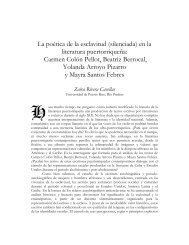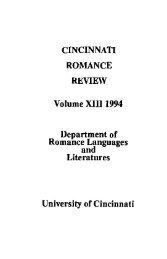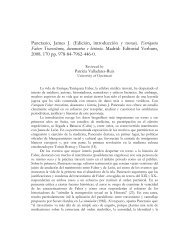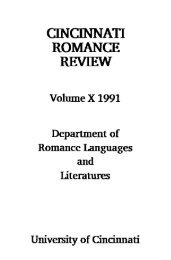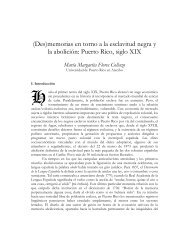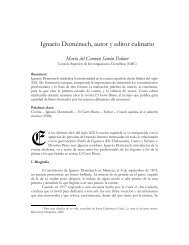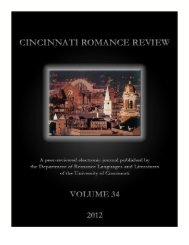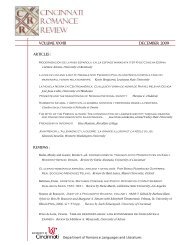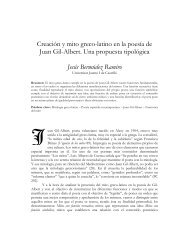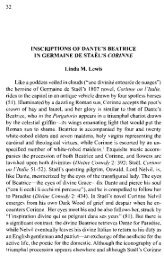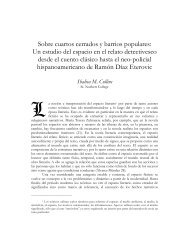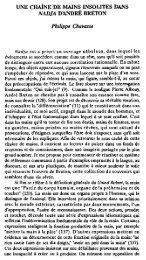Volume 30 (2011) - Cincinnati Romance Review
Volume 30 (2011) - Cincinnati Romance Review
Volume 30 (2011) - Cincinnati Romance Review
Create successful ePaper yourself
Turn your PDF publications into a flip-book with our unique Google optimized e-Paper software.
70 SONJA STEPHENSON WATSON<br />
Although Du Bois’s theory of double-consciousness does not include gender,, it<br />
incorporates the problematic of race that African Diaspora figures continue to face in<br />
the twenty-first century. The double bind/double- consciousness of Colón Pellot and de<br />
Burgos is multiple and deals with their multiracial heritage as women of color. The<br />
present study examines the intersection of race and gender in both of their writings<br />
building upon the theoretical framework of double bind/double-consciousness as<br />
espoused by Feal and Du Bois. This analysis also builds on the work of Consuelo<br />
López Springfield and Claudette Williams who analyze the themes of gender and race<br />
separately in their studies on the single authors. In “I am the Life, the Strength, the<br />
Woman: Feminism in Julia de Burgos’ Autobiographical Poetry,” López Springfield<br />
suggests that “at the heart of [Julia de Burgos’s] autobiographical poetry lies a rhetorical<br />
quest to justify a female poetics” and that the author “negotiated her own space<br />
between female aesthetics and male-constructed literary conventions” (56). In “‘Oh<br />
Lord, I Want to be White’: The Ambivalence of Mulatez in Carmen Colón Pellot’s<br />
Ambar mulato,” Williams argues that there are ways in which Colón Pellot’s poems both<br />
“coincide with and deviate from negrista practice” (32). Both articles are seminal studies<br />
on the individual writers and are among the first to analyze feminism (Julia de Burgos)<br />
and mulatez (Colón Pellot) in their separate studies. Their studies, however, do not<br />
analyze the intersection of race and gender and the problematic that this duality poses<br />
for these authors. Not only were they forced to define their bicultural heritage in a<br />
society that abhorred blackness, as precursors to the feminist movement, they also<br />
negotiated a feminine poet space to challenge the social mores of the period. It is<br />
through this critical lens that I (re)read the texts by Colón Pellot and de Burgos by<br />
interpreting race and gender, the theme of mulatez 1 , and the poets’s desire to attain<br />
whiteness. There are some challenges to the discussion of the interplay of race and<br />
gender in this study because of the perception of race in Latin America and the<br />
Caribbean on the one hand and the downplay of gender at the expense of race on the<br />
other. As Feal reminds us, blackness in Latin America relates “to the conscious- and<br />
unconscious- identification with a given racial group” (31). Furthermore, the<br />
intersection of race and gender becomes more complicated in the Hispanic Caribbean<br />
because as Williams notes, “Racial divisions complicate gender divisions in Caribbean<br />
societies…” (Charcoal and Cinnamon 7). As mulatas, Colón Pellot and de Burgos<br />
reconciled a dual heritage of blackness and whiteness that was complicated by their<br />
gender and the inferior status held of black women who were not afforded the same<br />
social status or sexual liberties as their white female counterparts. It remains important<br />
to study Colón Pellot and de Burgos within the context of race and gender in Puerto<br />
Rico because as Jiménez Muñoz suggests “dentro del contexto de la historia de la mujer<br />
______________________<br />
1 Mulatez is the harmonious coexistence of African and Hispanic heritage.<br />
<strong>Cincinnati</strong> <strong>Romance</strong> <strong>Review</strong> <strong>30</strong> (Winter <strong>2011</strong>): 69-82.



